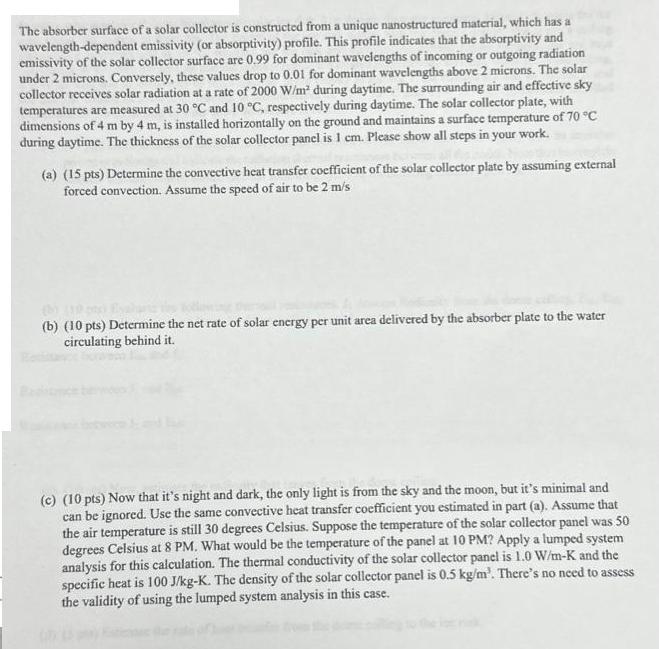Answered step by step
Verified Expert Solution
Question
1 Approved Answer
The absorber surface of a solar collector is constructed from a unique nanostructured material, which has a wavelength-dependent emissivity (or absorptivity) profile. This profile

The absorber surface of a solar collector is constructed from a unique nanostructured material, which has a wavelength-dependent emissivity (or absorptivity) profile. This profile indicates that the absorptivity and emissivity of the solar collector surface are 0.99 for dominant wavelengths of incoming or outgoing radiation under 2 microns. Conversely, these values drop to 0.01 for dominant wavelengths above 2 microns. The solar collector receives solar radiation at a rate of 2000 W/m during daytime. The surrounding air and effective sky temperatures are measured at 30 C and 10 C, respectively during daytime. The solar collector plate, with dimensions of 4 m by 4 m, is installed horizontally on the ground and maintains a surface temperature of 70 C during daytime. The thickness of the solar collector panel is 1 cm. Please show all steps in your work. (a) (15 pts) Determine the convective heat transfer coefficient of the solar collector plate by assuming external forced convection. Assume the speed of air to be 2 m/s (b) (10 pts) Determine the net rate of solar energy per unit area delivered by the absorber plate to the water circulating behind it. (c) (10 pts) Now that it's night and dark, the only light is from the sky and the moon, but it's minimal and can be ignored. Use the same convective heat transfer coefficient you estimated in part (a). Assume that the air temperature is still 30 degrees Celsius. Suppose the temperature of the solar collector panel was 50 degrees Celsius at 8 PM. What would be the temperature of the panel at 10 PM? Apply a lumped system analysis for this calculation. The thermal conductivity of the solar collector panel is 1.0 W/m-K and the specific heat is 100 J/kg-K. The density of the solar collector panel is 0.5 kg/m. There's no need to assess the validity of using the lumped system analysis in this case.
Step by Step Solution
There are 3 Steps involved in it
Step: 1
Steps Step 1 of 2 a Heat Transfer Coefficient h Given data Solar collector plate dimensions 4m x 4m ...
Get Instant Access to Expert-Tailored Solutions
See step-by-step solutions with expert insights and AI powered tools for academic success
Step: 2

Step: 3

Ace Your Homework with AI
Get the answers you need in no time with our AI-driven, step-by-step assistance
Get Started


